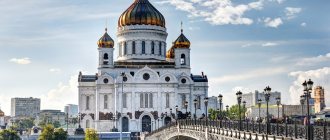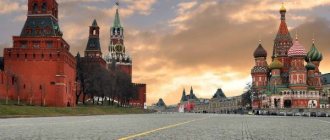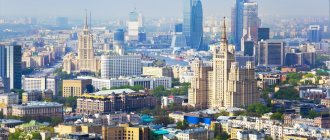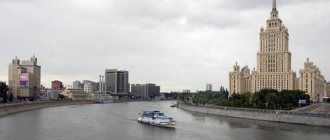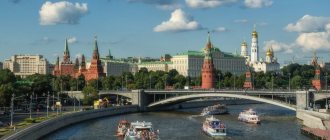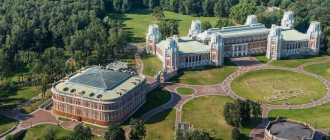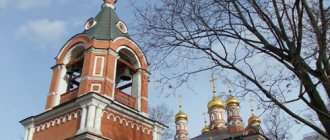Let's start with the main thing.
The mosquitoes in the Moscow region completely demolished the tower. If earlier insects acted more and more alone, now they are entire groups. Organized no worse than maroon berets.
While one little creature, like a fisherman in winter, is making a hole in its neck, its aggressive sidekicks are gnawing on its calves. Ten minutes later they are joined by thugs from nearby villages. A typical Moscow loser who leaves the city without a Raptor becomes the property of a mosquito public. Rumors about him spread like lightning.
So I advise you not to repeat my mistakes. If, of course, you also take a risk and go beyond the glorious city of Mozhaisk. Where, according to legend, living water can be found. It has been bubbling out of the ground for several centuries. And it gives people strength.
The source, based on the number of springs, was called Seven Springs. And they even assigned the territory (with an area of 144 hectares) the status of “natural monument of regional significance.”
Source "Gremyachiy" in Malinniki
Popular rumor says that this is one of the most miraculous sources. It is located 14 km from Sergiev Posad, near the village of Vzglyadnevo, on the left bank of the Vondiga River. A spring appeared about 600 years ago at the place where St. Sergius of Radonezh stopped to rest. The saint prayed earnestly for the unification of the Russian people and liberation from the Mongol-Tatar yoke, and suddenly a pure spring came from the mountain. It is also interesting that the water of the source is slightly mineralized and is close in composition to the Kislovodsk Narzan, so experts advise drinking it in limited quantities as a medicinal source.
Each of the streams of this key is credited with different healing properties: the right one – “from the heart”, the middle one – “from the head”, the left one – “from female diseases”. To approach the source, you need to climb a wooden staircase with several rest areas. The bathhouse, consisting of an open pond under a roof and a closed room, is located to the right of it. You can take water procedures in the font, or you can stand under the falling stream. They say the water temperature there is +4 degrees all year round. Experienced pilgrims advise coming on weekdays, because there are too many people on weekends.
How to get there
By car
From Yaroslavskoye Highway, turn onto the Small Concrete Ring (MBK) to the right towards the M7 highway. After 7 km there will be a large holiday village called Voronino. From there, 3 km until you turn right onto a dirt road to the source. There is no pointer there. From the MBK turn, drive 500 meters down to the bridge over the Karpovka River. Then 1.3 km to the lowland of the Karpovka River with a tributary stream along a dirt road and 1.2 km to the fork in the roads to the villages of Vzglyadnevo (left) and Voronino (right). From the fork, turn 700 meters to the right to the village of Vzglyadnevo along a dirt road that rises onto a field and goes around the village.
On your own
By train from Yaroslavsky station to Sergiev Posad station. At the station there will be bus number 120 to the village of Voronino (there is a store at the stop). Then 30 meters forward and turn right onto the country road. Walk past a long row of houses, past the Karpovka River and climb to the village of Voronino (1.5 km). From here, take a difficult-to-pass dirt road 1 km to the fork.
There are raspberries here, Protva
I will try not to write about mosquitoes anymore. But you still remember that they were nearby all the way. Their exhausting squeak was like the sound of a dive bomber. I destroyed them like Captain Titarenko, the same Maestro from the film. But there was almost no sense in this. New squadrons flew in to replace the killed ones...
In general, not a word more about them. Just don't forget that they are there. That they are nearby. In every paragraph and sentence.
The nature in the Moscow region is incredible (if only there were no mosquitoes!). In the photo - broadleaf bell. Photo: Pavel KLOKOV
Well, in the village of Semenkovo, too, which I reached by bus No. 35 (flight “Mozhaisk-Vereya”, runs every hour from the sixth platform of the bus station, ticket price is 70 rubles).
I interviewed the garbage truck driver at the waste bins.
“Seven springs... Living water... Reserve... Nope, I haven’t heard of it.”
I have long noticed that we do not see the miracles that are nearby. In the Solnechnogorsk region, for example, I once talked with a local aborigine living two kilometers from Bottomless Lake. This is a unique body of water with a perfectly round shape, the origin of which is debated by scientists. Prokopenko from Ren-TV is filming stories about him. And this one in the Afghan Panama hat hears for the first time... Although he has lived here all his life.
In general, tourist guides help me. And they say that you need to go further towards the village of Zolotkovo and then to the right along the Protva (the left tributary of the Oka). Which is what I did.
In Protva you can catch all kinds of fish - bleak, roach, gudgeon, pike, bream, perch. Photo: Pavel KLOKOV
By the way, there is not a word in the guidebooks about the miraculous water; all sorts of public pages on social networks and websites stuffed with fakes are increasingly suffering from this. But everywhere they talk about the incredible beauty of these same springs. About fabulous and picturesque waterfalls washing moss. About black kites flying above them. About the poisonous bush wolf's bast. And about a fish that is quite rare for these places - the common bitterling. In short, I went to the place where the birds do not stop talking and the jasmine does not fade, and where the sky merges with the earth.
Here I would like to add a little about mosquitoes, but I promised... Not a word more about the fact that they have gone crazy. And about the fact that they took a liter of blood from me, too.
“Hold on, son, rivers, no matter what,” a resident of Zolotkovo told me at the very edge of the village (she had heard about the Seven Springs, but had never seen it herself).
"No matter what?"
Savvino-Storozhevsky Monastery
It is located 50 kilometers from Moscow, on the left bank of both the Moscow River and the Razvarnya River. Founded in 1398 by the Monk Savva of Storozhevsky, a student of Sergius of Radonezh. This monastery has always enjoyed the favor of Russian sovereigns. Here, on the outskirts of Zvenigorod, Tsar Ivan IV the Terrible and his wife Anastasia Romanovna came to venerate the relics of the Monk Sava, and later their son Feodor Ioannovich.
Today's pilgrims can purchase delicious home-made bread and kvass at the monastery. About 700 meters from the monastery are the monastery and spring of St. Sava. A magnificent wooden chapel has recently been erected over the spring. You can swim there in summer and winter. The chapel has two large fonts: men's and women's, with spacious dressing rooms.
How to get there
By car
It is better to drive along the Novorizhskoe highway to Zvenigorod. Then go to the sign “Savvino-Storozhevsky Monastery”.
On your own
From Belorussky railway station to Zvenigorod station. From there, take bus No. 23 or 51 to the “D/O Ministry of Defense” stop. To get to the monastery, you need to leave the monastery, turn left and walk along a narrow asphalt road down the edge of a deep ravine.
It's like honey for tourists here
Then I came out into a clearing with two wooden benches. Then he walked up the metal stairs. And I found myself at the main entrance to the reserve. Where there is a sign with the inscription: “Natural monument of regional significance “Seven Keys”.
And next to it is a list of what is prohibited to do in this territory (officially, according to Decree of the Government of the Moscow Region No. 821/35):
- make fires;
- hunt;
- To cut down forest;
- collect plants;
- enter by any transport;
- build something;
- herd livestock;
- and arrange camping.
Grilling kebabs in the reserve is strictly prohibited.
Photo: Pavel KLOKOV That is, this is where we had to enter - from the territory of SNT “Rodniki”. And I had to take the 35th bus not to Semenkovo, but to the stop “Nadezhda Gardens” (it’s next).
“We don’t know where to get away from these tourists anymore,” a local resident told me while I slapped my neck, killing mosquitoes (ouch!). “Now even though they’ve given it the status of a monument, they seem to be afraid to mess things up.” Previously, they would come on boats and let us walk until the morning. And then clean up the trash for us.
The path from Semenkovo is considered roundabout - it is better to drive up to the Rodniki SNT by car (there is the main entrance to the reserve). Photo: Pavel KLOKOV
Regarding the fact that water from the springs has some healing properties, the pensioner grinned. There’s nothing like that in her, he says. Except lime. You start to boil and a white tint appears. So it's better not to drink it at all. For this purpose, here in the village there are wells in the wells. And the city has running water.
Our information
“Seven Keys” is a natural monument of regional significance.
This place became a specially protected area in 2009.
Photo: Pavel KLOKOV Address: Moscow region, Naro-Fominsk urban district, between the villages of Zolotkovo, Semenkovo, Pushkarka and Merchalovo.
Area: 144.66 hectares.
Altitude above sea level: from 167 to 214 meters.
Habitat: 78 species of vertebrates belonging to 19 orders of five classes, including ten species of fish, four species of amphibians, one species of reptiles, 47 species of birds and 17 species of mammals.
How to get there
Train + bus
Go to Mozhaisk by train from Belorussky Station, then by bus No. 35 to the “Nadezhda Gardens” stop.
Car
From Moscow along the Kyiv highway to Naro-Fominsk. Turn onto Naidova-Zhelezova street and on the Kubinskoe highway follow the sign “Tashirovo village”. Then go to the village of the Vereya Holiday Home. After which there will be a right turn towards the Rodniki gardening association.
David's Hermitage - Talezh
The Voznesenskaya Davidova Hermitage is located 80 km south of Moscow, near the city of Chekhov. The monastery stands on the banks of the Lopasni River, which flows into the Oka, on a high white-stone mountain. The monastery was founded on May 15, 1515 by the Monk David from the family of princes of Vyazemsky. Not far from the monastery, in the village of Talezh, there is a desert courtyard. There, from under the ground comes an abundant spring, consecrated in the name of the Monk David. A whole spring complex was built next to it: the temple of St. David, a belfry and two indoor baths - men's and women's. They say that healing from eye and liver diseases occurs at the spring.
How to get there
By car
Drive along the Simferopol highway, take the second turn towards Chekhov. At the sign for Kryukovo, turn off the highway and go straight all the way to the village of Novy Byt. To get to Talezh, you need to return to the Simferopol highway, cross it and continue straight towards Melikhovo. After about 10 km there will be a sign “Talezh. Source in the name of St. David”, where you need to turn left and get to the next sign “Holy Source”.
On your own
By train from Kursky station to Chekhov station, then by bus number 25 to the turn to Talezh, from there on foot 1.5 km.
Holy Kazan Convent
Located in the Tula region, in which there are 27 holy springs. The most revered of them is in the Holy Kazan Convent. It was founded according to the prophecy of the blessed elder Euphrosyne, in the world of Princess Vyazemskaya. She was from a noble family, received her education at the Smolny Institute and became a favorite maid of honor at the court of Catherine the Great. At some point, with two other ladies-in-waiting, she left Tsarskoe Selo and wandered around the monasteries until she found a spring near the village of Kolyupanovo, the water from which, according to legend, has life-giving powers.
The water from this spring is believed to cure all diseases and illnesses, especially cancer and blindness. Water flows from three pipes. There are two baths - women's and men's. Above the source there is a large cross, under it there is an inscription: “Take water from my well and you will be healthy.”
How to get there
By car
Drive along the Simferopol highway and at the 114th kilometer turn following the sign for the city of Aleksin. Under no circumstances should you turn into Aleksin at the first sign - the bridge there is closed. You need to drive further along the highway, and after 10 kilometers there will be a turn in the Yasnogorsk area. When you reach Aleksin, ask where the source is.
On your own
From Kursky station get to Tula. Next, take the Uzlovaya – Aleksin train from Ryazhsky station to Kolyupanovo station. Then walk about two kilometers along the path through the forest following the sign.
You are my springs, springs
Walking through the wet grass on a hot July day is even pleasant at first. There is a feeling of life-giving freshness. But gradually the sneakers become heavier and, having softened, begin to squelch. The wet earth sticks to the sole. And I really want to take off these shoes without touching them with my hands. And go barefoot. I didn't do this because I'm afraid of ticks. But there is another option. Normal people, I heard, take rubber boots with them when out of town, especially now, during the rainy season.
Forbs near the Seven Keys Nature Reserve smell like women's perfume. Photo: Pavel KLOKOV
The aromas of the July meadow deserve special description. Of course, I’m not Prishvin, but all this colorful variety of herbs smells like women’s perfume. After the concrete jungle my head is spinning. In the description of the protected area, the list of flora is endless. From the broad-leaved bellflower to the completely unknown to me spots of old grass and warty euonymus.
After three kilometers, I finally entered a small forest, where it was not so stuffy under the treetops. And a few minutes later I heard the sound of water (in principle, there are no signs to the Seven Springs from Zolotkov). This was one of the springs about which, in fact, I am writing. Like a real traveler, exhausted by the scorching sun, I took my modest belongings off my back (a backpack with an iPhone charger and an empty bottle) and, bending my knee, washed my face. The water is ice-cold and looks very clean. Thirty meters later I found another key. It is difficult not to notice it, because it is perpendicular to the path. And it makes more noise than the first one.
The very first spring, if you go from the Zolotkovo SNT. Photo: Pavel KLOKOV
And then, one might say, the culmination. I reached those very picturesque waterfalls that guidebooks write about. True, they are located almost at Protva itself, and I stood at the top - five meters from them. Later, residents of the local SNT told me that there were steps to the springs, but in the spring after the flood they were washed away. I had to literally slide down a slippery slope and, once in the middle, jump down. Without any boasting, I will say that not every tourist will decide to do this. An unsuccessful landing and you end up lying in the swamp, dirty and bruised. But I was lucky because I didn't fall.
The waterfalls really look gorgeous.
“Especially if you go down the river in a kayak,” tourists write in reviews of the Seven Keys. “You can meditate to the sound of the water.”
Or, for example, make a movie. A new version of Tom Sawyer. I can see two boys sitting against the backdrop of these foaming streams, smoking a pipe, contentedly.
Well, I filled a bottle of water, photographed the beauty from different angles and climbed back.
Here I propose to get into the situation. And imagine my crooked, trembling fingers clinging to the slope and treacherously sliding down. I grabbed tree roots and nettles. I twisted my legs into the first position. Helped with elbows and knees. It expired later. And finally I reached a tree that I could safely and securely hold on to. Further on, the slope is no longer so steep, and I, choosing dry places, reached the top along them, like islands. He exhaled. And looking down, he imagined something terrible. How I lie with a broken leg and, washed by magical spring water, call for help.
Ugh. Ugh. Ugh.
The steps to the springs have been washed away and now there is a steep cliff instead. Photo: Pavel KLOKOV
If you arrive and there are no steps, tie a rope to a tree and calmly go down. Or you can approach this place along the river. Especially now, in this heat.
Optina Pustyn – Shamordino
The desert is located on the banks of the fast river Zhizdra, cutting it off from the rest of the world, and is surrounded by forest. The Holy Vvedensky Monastery is one of the oldest in Russia. According to local legend, the monastery was founded by the ataman of a gang of robbers, nicknamed Opta, who repented and took monastic vows with the name Macarius. L.N. Tolstoy, F.M. Dostoevsky, N.V. Gogol visited here. Near the monastery on the bank of the Zhizdra River there is a spring of St. Paphnutius with a font. It's easy to find. You need to leave the monastery gate, turn right and walk along the forest along a country road to a metal barrier. Then go out onto the path that this barrier blocks and walk along the river bed. After 350 meters there will be a fenced spring.
How to get there
By car
Drive along the Kievskoye Highway, passing the turn to Kaluga. At the 186th kilometer of the highway you need to cross a road bridge, after which there will be a sign for Optina. Next we head towards Kozelsk - straight ahead all the time and near the monument following the sign to the right. There, go to the traffic light and turn left. After the bridge over the river, take the first left (there is a sign there). The road from the highway to Kozelsk is for the most part not bad, but you can also drive through Kaluga, especially on the way back; signs for Moscow lead through Kaluga.
On your own
A bus leaves daily from the Yugo-Zapadnaya metro station on the route Moscow - Kozelsk. From the bus station in Kozelsk to the monastery it is about three kilometers.
Holy springs of the Sheremetev estate (Chirkino village)
The estate in the village of Chirkino is the first ancient estate of the Sheremetev boyars. Near the village there are many pure, consecrated water sources. One of them is located in a lowland, directly under the temples of the village of Chirkino rising on the mountain. This is the source of “Joy to All Who Sorrow.” It is famous for its extraordinary concentration of silver. Its content in water exceeds the normal norm by twenty times! There is a bathhouse next to the spring.
Two other sources are located at the entrance to the temple complex, near the village of Shcherbinino, near the bridge over the river. The fourth source is especially famous - the ancient miraculous source of the prophet Elijah. It is mentioned in many historical descriptions, chronicles and church historiography of the Kolomna district of the 18th century.
